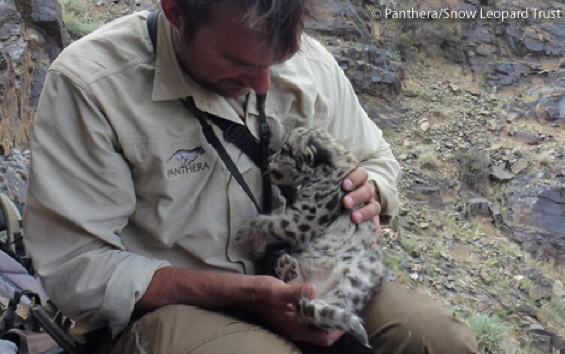 Field Scientist Mattia Colombo carefully prepares to place a cub back into its den. Courtesy of Panthera |
Panthera, a wild cat conservation group, and the Snow Leopard Trust have released the first footage of snow leopards with their mothers in their dens in Mongolia.
The videos, released July 12, show a female with two cubs in a “partially man-made den” and another mother with a single cub in Mongolia’s Tost Mountains. In both instances, the camera was set up when the mothers were away hunting, according to the groups. The researchers weighed, measured and photographed the cubs before their mothers returned.
“We have spent years trying to determine when and where snow leopards give birth, the size of their litters, and the chances a cub has of surviving into adulthood,” said Tom McCarthy, Executive Director of Panthera’s Snow Leopard Program. “This is one of those exceptional moments in conservation where after years of effort, we get a rare glimpse into the life of an animal that needs our help in surviving in today’s world. These data will help ensure a future for these incredible animals.”
“Knowledge about the first days and weeks of life is vital to our understanding of how big cat populations work, and how likely it is for a newborn to reach adulthood and contribute to a healthy population. A valid conservation program requires such information, which this new development in snow leopard research provides,” added Howard Quigley, Panthera’s Executive Director of both Jaguar and Cougar Programs.
Snow leopards are difficult to capture on camera due to their secretive nature and their extreme habitat.
The species is listed as “Endangered” on the IUCN Red List due to habitat loss, poaching, and human-wildlife conflict over livestock.
Related articles

(10/28/2008) The snow leopard (Panthera uncia) is one of the rarest and most elusive big cat species with a population of 4,500 to 7,500 spread across a range of 1.2 to 1.6 million kilometers in some of the world's harshest and most desolate landscapes. Found in arid environments and at elevations sometimes reaching 18,000 feet (5,500 meters), the species faces great threats despite its extreme habitat. These threats vary across its range, but in all countries where it is found — Afghanistan, Bhutan, China, India, Kyrgyzstan, Kazakhstan, Nepal, Mongolia, Pakistan, Russia, Tajikistan, Uzbekistan and possibly Myanmar — the species is at risk. In some countries snow leopard are directly hunted for their pelt, in others they are imperiled by depletion of prey, loss of habitat, and killing as a predator of livestock. These threats, combined with the cat's large habitat requirements, means conservation through the establishment of protected areas alone may not be enough save it from extinction in the wild in many of the countries in which it lives. Working to stave off this fate in half a dozen of its range countries is the Snow Leopard Conservancy. Founded by Dr. Rodney Jackson, a biologist who has been studying snow leopard in the wild for 30 years, the Conservancy seeks to conserve the species by "promoting innovative grassroots measures that lead local people to become better stewards of endangered snow leopards, their prey, and habitat."







